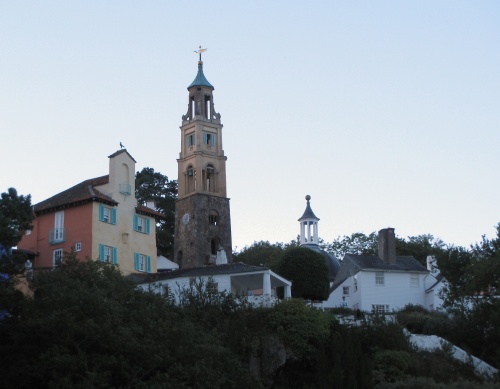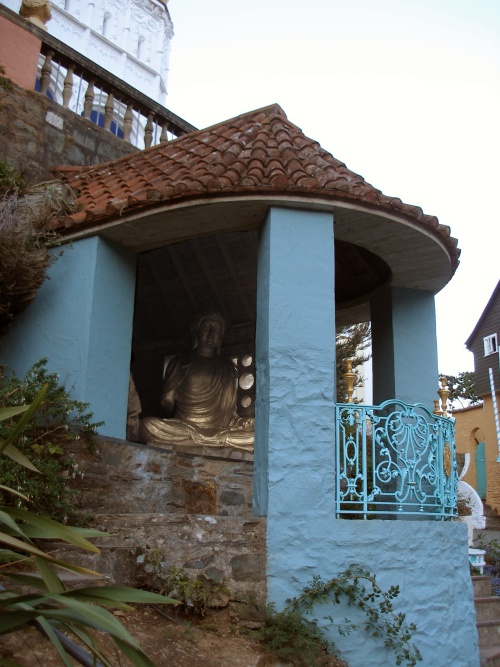Portmeirion - August 2005

Leaving Palm Springs and driving to Los Angeles, I flew back to London on Air New Zealand. In my personal opinion, DON'T fly with Air New Zealand. My friend Steve, who recently went to live in NZ, seems to love them, but I felt they were particularly poor for a 'world class' carrier. Rude cabin crew and the most outdated 'entertainment' technology (the only airline I've flown in many years that didn't have seatback TV with your own personal choice of movies). I laughed at the in-flight magazine that said these advances were being 'progressively' introduced, my view was that progressive meant you were at the front, leading. Next time I'll remember that, for just a few £s more, I can have a decent service from British Airways or Virgin.
Arrived back in London, after the 120° heat of Palm Springs, to a grey, raining London. The next day was just as bad, and on the day after I prepared to take a trip to the Orkneys, on the way to the Shetlands. A friend had arranged a trip to Kirkwall and Lerwick and I had decided to go along. He later dropped out and I was left holding the ferry tickets and hotel bookings.
Arrived at Kirkwall around 11pm and froze to death at the ferry terminal waiting for a taxi to the hotel, so by the next morning I was feeling quite under the weather! The rain continued, my mood worsened, and I decided I really wasn't in the frame of mind to spend any more time away from home.
Next morning I had breakfast, packed my things, and took the bus from outside St. Magnus Cathedral to the southern tip of the Orkneys and took a 45 minute ferry ride to John O'Groats. No time to stop, as soon as we were off the ferry we were bundled on a coach to Inverness, then a bus to Aberdeen airport, then a nice BA flight home.
For my birthday this year my friend Robin took me to Portmeirion. Some of you may recall that name as the location used for the infamous 'Village' in the 60's cult TV show 'The Prisoner'. Portmeirion sits at the edge of Tremadog Bay.
Clough Williams-Ellis bought Portmeirion (then called Aber Iâ) in 1925 and set about creating a unique place.
Many of the buildings in Portmeirion are built using features from old buildings (ceilings, windows, fireplaces, statues) that were demolished and offered to Clough or bought at auction.
Portmeirion has far more history than I can offer on this page, so instead I'll offer some comment to accompany my photos and suggest you look at their website - http://www.portmeirion-village.com/
The hotel was the original Aber Iâ mansion, built in 1850 and extended in 1926 and 1930. The dining room looks over the sea.
From the hotel gardens you can look up at one of the main features of the village, the Bell Tower; that housed an old chiming turret clock from a demolished London brewery.
To the left of the Bell Tower in my photo is the Government House, now a self-catering cottage.
My next photo shows the Bristol Colonnade. Built in 1760 and damaged by bombing it had fallen into ruin. It was transported and rebuilt at Portmeirion in 1959.
The Colonnade is one of the many features to be found in the Piazza, built to replace a tennis court. The Piazza also features Ionic columns with gilded Burmese dancing figures.
In the photo you can also see the Pantheon. In Clough felt that the village needed a decent domed structure, and in 1961 the Pantheon was completed. A vast Norman Shaw fireplace was used as the gothic porch.
Just above the Piazza and below the dome is a pantiled loggia housing a gilt statue of Buddha salvaged from the shooting of the film 'The Inn of the Sixth Happiness' starring Ingrid Bergman.
The statue of Hercules (by William Brodie) was acquired in 1960, driven on the back of a truck from Aberdeen to Portmeirion. I think you will agree Hercules is an exceptionally fine statue.
The next photo shows the Round House which should be instantly recognised by any Prisoner fan as the home of Number 6. On visiting Portmeirion some people are surprised at how small the interior is, as all the interiors were shot in the studio. The Round House now is home to the Prisoner Shop, Number Six.
Of course there's lots more to do when staying at Portmeirion than just marvel at all the buildings, statues and monuments. There is a great steam railway (more on that in a moment), great coastal scenery and some fine opportunities for sightseeing.
A few miles to the west of Portmeirion is Criccieth Castle. The castle sits atop a hill overlooking Tremadog Bay and the town and dates from the 13th century.
The Ffestiniog Railway is the Oldest Independent Railway Company in the World. You can travel by steam through the spectacular scenery of the Snowdonia National Park, between Porthmadog and Blaenau Ffestiniog.

St Magnus Cathedral

Next stop Lands End

The Hotel at Portmeirion

The Bell Tower, with the Government House to the left

The village by night

The Bristol Colonnade

A view of the Piazza with the Bristol Colonnade and the Pantheon

A wider view of the Piazza taking in the Bell Tower

The Buddha from 'The Inn of the Sixth Happiness'

The statue of Hercules

The Round House, home to Number 6 in 'The Prisoner'
 Criccieth Castle
Criccieth Castle

The Ffestiniog steam railway at Ffestiniog station

Approaching Porthmadog on the train